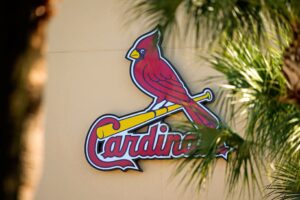When the announcement was made a few weeks ago that 20 year-old Atlanta Braves pitching prospect AJ Smith-Shawver would be making his major league debut, manager Brian Snitker commented that he would be getting the Spencer Strider treatment. By that general comparison the Braves manager meant that, like Strider did in 2022, Smith-Shawver would begin his major league career in the Braves’ bullpen.
Nevertheless, comparisons between the two are easy. And why not? At first glance, both these exciting young Braves pitching prospects came out of nowhere to earn a promotion to the Show. However, the comps between the two pitchers more or less cease at that general idea.
Since they’re so freaking exciting though, here’s a breakdown of Smith-Shawver’s outlook, as well as some granular analysis of him and his new teammate Strider.
AJ Smith-Shawver vs. Spencer Strider
Strider is four years older, came up as a college pitcher and already has Tommy John surgery under his belt. Smith-Shawver just graduated high school in 2021 and only started pitching his senior year. He played third base in high school and was recruited by Texas Tech as a quarterback. Scuttlebutt has it that Smith-Shawver can sling a football 80 yards.
Both pitchers logged absurdly few innings in the minor leagues – with Strider going 94 innings in just the single season of 2021 before getting the call. Smith-Shawver spread his 100+ farm system innings between rookie ball at age 18 in 2021 until this year, where he spent time at three levels of High-A, AA and AAA. The kid’s suitcase probably needs a rest.
Strider was promoted to the Bigs and appeared in 11 games as a reliever before going on to start 20 in a dominant 2022 rookie season. In getting Strider-like treatment, technically that happened. Smith-Shawver started in the bullpen, but it was three innings in one appearance before he was promoted to the starting rotation at the expense of Michael Soroka.
AJ Smith-Shawver, Nasty 78mph Curveball. 😨 pic.twitter.com/PhpzXPZvvH
— Rob Friedman (@PitchingNinja) June 16, 2023
Smith-Shawver draws upon a more conventional four-pitch array, while Strider defies the mold for starting pitching, primarily throwing just two pitches. This heavy reliance on two pitches has previously profiled more as a reliever.
However, research cited by The Atlhletic’s Eno Sarris on the excellent podcast Rates & Barrels seems to indicate having an elite slider and a competent fastball, while coupling those with great location, might be closer to the new paradigm for an effective major league starting pitcher. In Strider’s case, he’s elevating it to ace profile.
Analytics Analysis
The Unicorn
Strider is a bit of a unicorn in all fairness. He possesses unique shape and movement to his fastball, which touches 100 mph and sits comfortably in the upper 90s. Strider utilizes the pitch almost 60% of the time, which he pairs semi-exclusively with a mid-80s slider that generates an absolutely gaudy 55.8% Whiff rate.
Because Strider also gets almost 30% Whiffs on his fastball, these two elite pitches prove to be all he needs for the most part. He only deploys his changeup 6% of the time, even though it gets 50% Whiffs. This makes it an excellent third pitch, should he ever decide to sequence it into his arsenal more effectively.
The Unknown Prodigy
Smith-Shawver features a more traditional four-pitch mix of fastball, slider, curve and what Statcast classifies as a changeup but appeared to be a splitter – as Tom Glavine remarked during the Braves’ broadcast of Smith-Shawver’s start against the Colorado Rockies on June 15.
Like Strider, Smith-Shawver relies primarily on his fastball at 54%, but it isn’t the ungodly piece that Strider’s has shown to be.
In fact, AJ Smith-Shawver can’t really be considered a flamethrower, even though he touches 98 mph. His fastball averages 94 mph and can sit in the low 90s. However, he throws four pitches and uses his fourth pitch, the splitter, as often as Strider uses his third pitch, the changeup.
Even though Smith-Shawver’s 12% usage of his third pitch, the curve, might seem insignificantly bigger than Strider’s 6% usage of his third pitch – that 6% makes a difference.
Research has shown that pitches used above 10% of the time become more effective by way of making the other pitchers that much better. Throwing a third pitch more than 10% of the time forces hitters to juggle more options when determining what’s coming at them.
Smith-Shawver’s splitter gets 50% Whiffs. That’s straight fire for a fourth pitch.
AJ Smith-Shawver is the youngest Braves starter (20 years-201 days) to throw 5 IP or more since Steve Avery in 1990. pic.twitter.com/w1mbu9qmvQ
— ESPN Stats & Info (@ESPNStatsInfo) June 10, 2023
Stuff+ + Statcast
Since AJ Smith-Shawver only has 13 major league innings compared to Strider’s 78 innings in 2023, the sample size isn’t ideal for a side-by-side. Nevertheless, when employing Eno Sarris’ Stuff+ pitching model, the dissimilarities between the pitchers become much more stark.
Stuff+ measures not only effectiveness of pitches but also shape and movement quality.
Strider’s fastball grades out as 146 Stuff+ – which is eighth best in the league when sorting by 10 innings or more pitched. Within these search field parameters, Smith-Shawver’s fastball is 468th in the league at 80 Stuff+.
It should be noted that while he was in the minors, he was rated by the Stuff+ system utilized in the minors as a top 10 pitcher. So even though Stuff+ supposedly is less affected by sample size than other models, it’s still a new system in flux, and Smith-Shawver may start trending up on that leaderboard soon.
Regardless of the analytic rabbit hole, hitters let a pitcher know how good their stuff is. And AJ Smith-Shawver’s fastball, by results, has been well below average. While Smith-Shawver gets elite Whiff rates on his two breakers – with the slider at 36% and the curve at 45% – his fastball lags behind at a paltry 9.5%.
The good news, though, is batters are only hitting .179 against the fastball. Working on location and pitch sequencing with major league coaches and talent would undoubtedly optimize Smith-Shawver’s repertoire to bring out the best in his four-pitch tool kit.
Tom Glavine’s Take
In Smith-Shawver’s second start, which came against the Colorado Rockies, Hall of Famer Tom Glavine made the comment from the announcers’ booth that the Braves pitchers didn’t need to be perfect, because the Braves offense was so good.
Glavine went on to say: if Braves pitchers could hold the opposition to just a few runs, it would give the team a chance to win. That’s precisely what Smith-Shawver went on to do over 5 2/3 innings.
This outing happened to be just Smith-Shawver’s 31st professional appearance. By way of comparison – calling back to another meteoric rise by a Braves pitching prospect – Steve Avery took 36 professional starts before he even made it to AAA.
The 20-year old, recently converted pitcher also needed to work on consistency with command. He also needs to harness his breaking balls, according to Glavine.
AJ Smith-Shawver gave up his first home run to catcher Elias Diaz on a slider that just didn’t slide. But this was after delivering a crisp 87 mph slide-piece that froze Diaz.
AJ Smith-Shawver pitched a heck of a GEM tonight 👏🏼
5.2 IP
3 ER
6 H
1 BB
6 K
3.65 xFIP31% Whiff rate
▪️40% whiff rate or better on his curve, slider and changeup pic.twitter.com/zZ9DKTsNvD— Kevin Keneely (@KevinKeneely1) June 16, 2023
Final Answer
So, is AJ the next Spencer? Definitely. In that he’s unique as hell and can help the Braves win now, despite a lack of pro experience.
Are the two similar as pitchers though? Probably not. But since Spencer the unicorn is known for his predilection for imitation and impersonation, one could say that even Spencer Strider isn’t Spencer Strider. And certainly, the results lately haven’t been up to Strider’s benchmark of personal greatness.
Yet, Strider will figure things out – just as Smith-Shawver will learn how to locate slider – so as to not leave hangers for hitters to bang.
And as Glavine punched home: as long as the Braves offense continues to thrive, the pitchers don’t have to be flawless to win games.
One thing early returns do seem to suggest is that the two pitchers share a certain unflappable moxie on the mound. While it’s an intangible, Smith-Shawver flashed Strider-esque mojo when he got into the biggest jam of the evening after the Braves gave him a 5-3 lead.
Diaz, who served up Smith-Shawver’s first home run allowed, came to the plate with two on. A few pitches later, he fell to one knee and looked puzzled after Smith-Shawver fired his fourth most frequently utilized pitch – the splitter – to strike Diaz out and end the inning.
Photo Credit- Brett Davis-USA TODAY Sports
Players Mentioned- AJ Smith-Shawver, Spencer Strider, Michael Soroka, Tom Glavine, Steve Avery, Elias Diaz






